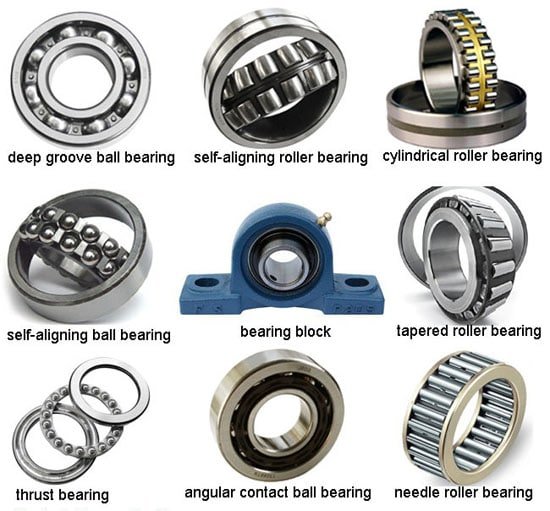Classification of bearings
A bearing is the basic element of any rotating mechanism. You can observe bearing is any simple mechanism, for example, the fan at your home, the mixture in your kitchen, your bicycle contain bearing inside it. There are various types of the bearings as per their application. Here is the basic classification of bearings which are most common.
Classification of bearings

Depending upon the direction of the force
Radia bearing: Radial bearing supports the load which is perpendicular to the axis of the shaft
Thurst bearing: Thurst bearing supports the load which acts along the axis of the shaft
Depending upon the type of friction
Sliding contact bearing
In this type of bearings, the surface of the shaft slides over the surface of the bush. To prevent friction, both surfaces are separated by a thin film of lubricating oil. Generally, Bush is made from bronze or white metal.
Example: Plain bearing, journal bearing, sleeve bearing
Rolling contact bearing or anti-friction bearing
Here rolling friction comes into play. This bearing is also called anti-friction bearing as friction is negligible which is in range of 0.005 to 0.003 fR.C.
Example: Bearings used in automobile axle, gearbox, machine tool spindles, small electric motor
Types of rolling contact bearings
Deep groove ball bearing
In this type of bearings, the radius of the ball is slightly less than the radius of curvature of the groove. This creates point contact. Thus friction is less and so it can be used in high-speed applications. Due to low friction, temperature rise and the noise level is also low. It can take axial as well as radial loads.
Cylindrical roller bearing
These bearing are used where high load carrying capacity is required. Here rolling elements are cylindrical in shape instead of balls as in deep groove ball bearing. It gives line contact and same as previous case friction loss is less so it can be used in the high sped application. This bearing can not take thrust load.
Angular contact bearing
This type of bearing is designed in such a way that line of reaction at the point of contacts for a ball at the inner race and outer race, make an angle with the axis of the bearing. Due to this, it can take the radial and axial loads simultaneously.
Load carrying capacity of such bearings is high compared to deep groove ball bearings. However, two bearings are required to take thrust load in both directions.
Self-aligning bearing
In this type of bearing, the external surface of the bearing bush is made spherical. The centre of this spherical surface is at the centre of the bearing so it can align itself with the journal. It is used to compensate any misalignment. It can take both radial and axial loads.
Taper roller bearing
Here rolling elements are rollers. They are arranged in such a way that axes of individual rolling elements intersect at a common point at the axis of the bearing. This is for the pure rolling motion.
Two bearings are required to take axial loads.
This type of bearings is commonly used in automobile, railway and machine tools.
Thurst ball bearing
Thurst ball bearing consist two row of balls. Balls, inner and outer race are made from high carbon chromium steel while the roller is made from case hardened steel. These bearings are generally used in the gearbox.
Due to a large number of balls, it can take comparatively high thrust load. However,, it can take thrust loading single direction only.
Also read: Types of mechanism
Summary
In addition to above, there are many different types of bearings used in specific applications. This is the basic classification of bearings, which are commonly used in day to day life.



keep up the good work, I read few posts on this web site and I think that your website is very interesting and has lots of excellent information.